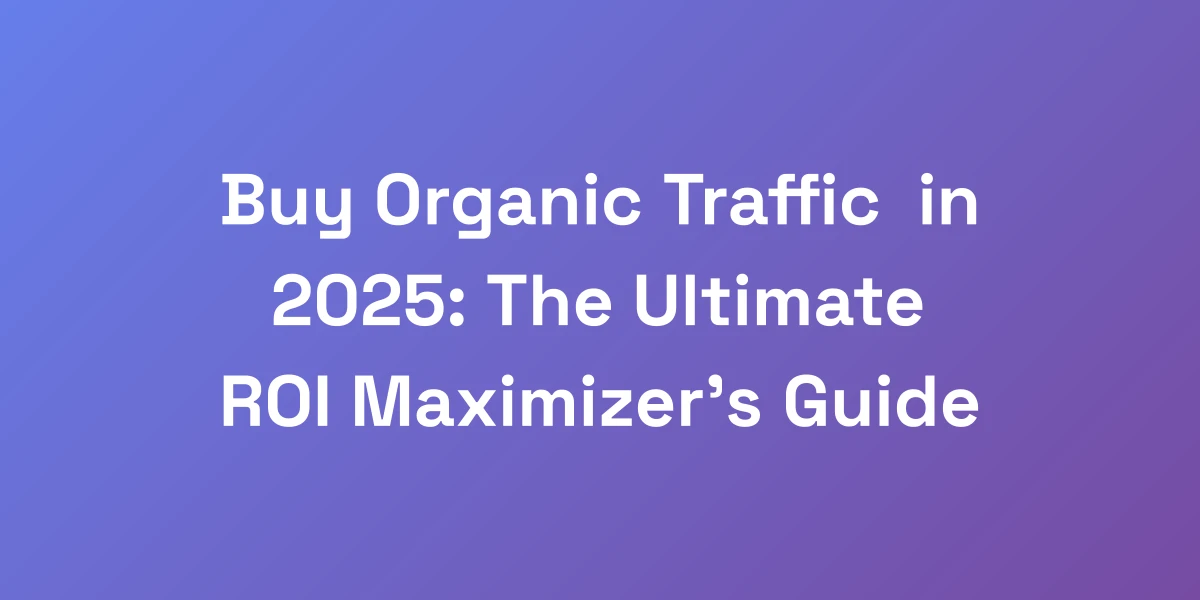
Analyze Competitor Website Traffic: The Ultimate 2025 Playbook
Apr 7, 2025 | By [email protected]
Why Most Businesses Fail at Competitor Traffic Analysis (And How to Win)
Let us hit you with some truth: 90% of businesses are doing competitor analysis wrong.
They’re obsessing over vanity metrics while missing the real money-making insights hiding in plain sight.
We’ve spent millions on ads and built multiple 8-figure businesses by mastering this game.
Here’s the thing – it’s not about how much traffic your competitors get; it’s about understanding why they get it and where they’re leaving money on the table.
In this playbook, we’re going to show you exactly how to extract the insights that matter.
The Hidden Cost of Poor Competitor Analysis
Imagine pouring resources into strategies that lead nowhere because you misread your competitors’ moves.
The hidden cost? Lost opportunities, wasted budgets, and stagnated growth.
Shoddy competitor analysis can leave you blind to market shifts and blind spots in your strategy.
Think about Styra’s case study where meticulous SEO analysis skyrocketed their organic traffic by over 100%.
Without such precision, where could your business end up?
The Three Pillars of Effective Traffic Analysis
Effective competitor traffic analysis rests on three pillars:
- Comprehensive Data Collection: Gathering data from reliable sources ensures the accuracy of your analysis.
- Deep Interpretation: It’s not just about numbers; it’s about understanding the story behind them.
- Strategic Implementation: Turning insights into actionable strategies that drive results.
Each pillar supports the other, creating a robust framework for analyzing and leveraging competitor traffic.
Identify content gaps that you can fill with your own high-quality, unique content by leveraging business blogging strategies.
Common Mistakes That Keep You in the Dark
What holds businesses back from effective competitor analysis? Let’s break it down:
- Focusing Solely on Traffic Volume: It’s not just about the numbers; it’s about the quality and sources of traffic.
- Ignoring Contextual Factors: Google algorithm updates for 2024, market trends, and seasonal changes play a crucial role.
- Overlooking Behavioral Insights: Understanding visitor behavior can reveal why competitors succeed.
Avoiding these mistakes to avoid in SEO competitor analysis can transform your analysis from superficial to strategic.
Setting Up Your Analysis Framework
We don’t just wing it; we build a solid framework.
Start with identifying your key competitors using tools like SEMrush and Similarweb. For getting started with website analysis, refer to Similarweb’s support resources.
Next, establish the metrics that matter: traffic sources, visitor demographics, engagement metrics, and conversion rates.
Finally, create a timeline for regular analysis to stay updated with any shifts in competitor strategies.
This structured approach ensures you capture the most relevant and actionable data.
For a detailed step-by-step guide to analyzing competitor website traffic, follow this resource.
Quick Wins vs. Long-term Strategy
It’s tempting to go for quick wins, but balancing them with long-term strategies is essential.
Quick wins might include optimizing high-traffic keywords or tweaking ad campaigns based on competitor data.
Meanwhile, long-term strategies involve building a sustainable SEO foundation and developing unique value propositions.
Both are crucial, but knowing when to act and when to plan is what separates successful businesses from the rest. Additionally, consider SEO strategies for startups to tailor your approach effectively.
The Ultimate Stack: Essential Tools for Traffic Analysis in 2025
Stop wasting time with subpar tools.
After testing literally everything on the market, we’ve narrowed it down to a powerful stack that delivers actionable intelligence.
This isn’t about having the most expensive tools – it’s about having the right ones that give you the exact data points that drive revenue.
We’re going to show you how to combine these tools in ways most marketers never think of, creating a competitive advantage that’s hard to replicate.
Core Analytics Tools You Can’t Ignore
Your toolkit is incomplete without the essentials.
- SEMrush: Offers comprehensive tools for analyzing competitor website traffic and organic search rankings.
- Similarweb: Renowned for its ability to dissect traffic across various marketing channels.
- Ahrefs: Known for its robust link database and keyword analysis capabilities.
These tools form the backbone of your traffic analysis, providing deep insights into your competitors’ strategies. For more options, explore competitor monitoring tools.
Free vs. Paid Tools: What’s Actually Worth It
Not all tools are created equal, and here’s the scoop:
- Free Tools: Great for getting started, but they often lack depth and detailed data needed for comprehensive analysis.
- Paid Tools: Invest in tools like SEMrush or Similarweb for advanced features, accurate data, and actionable insights.
When it comes to serious competitor analysis, going beyond free tools is non-negotiable.
Setting Up Your Dashboard for Maximum Insight
A cluttered dashboard is a recipe for confusion.
Focus on key metrics: traffic sources, top-performing pages, user engagement, and conversion rates.
Use tools like Google Data Studio to integrate data from SEMrush, Similarweb, and Ahrefs into a single cohesive dashboard.
This centralized view allows you to quickly identify trends and make informed decisions.
Advanced Tool Combinations for Deep Insights
Combining tools can unlock deeper levels of insight.
For instance, pair SEMrush’s keyword analysis with Ahrefs’ backlink data to understand the full picture of a competitor’s SEO strategy.
Integrate Similarweb’s traffic sources with Google Analytics to see how different channels contribute to your competitors’ success. Additionally, utilize SEO automation tools to streamline your SEO strategy.
This multi-faceted approach provides a more comprehensive understanding of their strategies.
Automation and Integration Strategies
Manual analysis is time-consuming and error-prone.
Automate data collection and reporting with tools like Zapier or Integromat, and explore marketing automation for agencies to save time and ensure consistency.
Set up regular updates and alerts to stay on top of any significant changes in competitor traffic patterns.
Automation ensures you’re always working with the latest data without the hassle.
Decoding Your Competitor’s Traffic Sources and Strategy
Here’s where we get into the meat.
We’re going to show you how to reverse engineer your competitor’s entire traffic strategy in under 60 minutes.
This isn’t just about where they get traffic – it’s about understanding why they get it and where they’re leaving money on the table.
The best part? Once you understand this, you can identify gaps in their strategy and exploit them for massive gains.
This is the exact process we’ve used to scale multiple businesses.
Breaking Down Organic Traffic Patterns
Organic traffic is the lifeblood of long-term SEO success.
Use SEMrush to identify the top-performing keywords driving traffic to your competitors. To effectively analyze competitor website traffic, consider additional tools and resources.
Analyze their content strategy: what topics are they covering, and how in-depth is their content?
Discover which pages are attracting the most organic traffic and why.
By understanding these patterns, you can tailor your own SEO strategy to capture similar traffic streams.
Paid Traffic Analysis and Opportunity Gaps
Paid traffic can provide immediate visibility.
Examine your competitors’ PPC campaigns using SEMrush’s advertising research tools.
Identify their high-spending keywords and the ad copy that resonates most with their audience.
Spot opportunity gaps where their campaigns are weak or absent, and capitalize on these areas with your own targeted ads.
This allows you to divert traffic that your competitors are missing out on.
Social Media Traffic Attribution
Social media is a powerful traffic source.
Use Similarweb to track the specific social platforms driving traffic to your competitors’ sites.
Analyze their engagement levels on each platform to determine where they’re most effective.
Implement similar strategies or find underutilized platforms to maximize your social media traffic.
This approach ensures you’re leveraging the same channels that are driving success for your competitors.
Email Marketing and Newsletter Analysis
Email marketing remains a significant traffic driver.
Sign up for your competitors’ newsletters to monitor their email campaigns.
Examine the frequency, content, and calls-to-action used in their emails.
Identify strategies that engage their audience and drive traffic back to their site.
Incorporate these insights into your own email marketing efforts to boost engagement and traffic.
Content Strategy Breakdown
Content is king, but quality reigns supreme.
Analyze the types of content your competitors are producing: blogs, videos, infographics, etc.
Use Ahrefs to determine which pieces are attracting the most backlinks and social shares.
Identify content gaps that you can fill with your own high-quality, unique content by leveraging business blogging strategies.
By outperforming your competitors’ content, you can capture a larger share of traffic.
Turning Data Into Dollars: Action Steps for Immediate Results
Let’s cut through the fluff and get to what actually makes money.
We’re going to show you how to take all this competitive intelligence and turn it into actionable steps that drive revenue.
This isn’t theory – these are the exact strategies we’ve used to generate over $100M in sales.
The key is focusing on the high-leverage actions that move the needle immediately while building for long-term dominance.
Priority Action Framework
Not all actions are created equal.
Develop a priority framework that categorizes actions based on their potential impact and ease of implementation.
Focus first on actions that offer the highest return with the least effort.
This ensures you’re making the most of your time and resources for immediate gains.
Quick Implementation Strategies
Speed is a competitive advantage.
Implement quick tweaks like optimizing meta descriptions, improving page load speeds, and enhancing mobile responsiveness.
Leverage data from your traffic analysis to make informed, swift changes.
These quick wins can lead to immediate traffic boosts and set the stage for larger initiatives.
ROI Tracking and Optimization
Measuring the effectiveness of your actions is crucial.
Set up clear KPIs to track the ROI of each implemented strategy.
Use tools like Google Analytics and SEMrush to monitor performance metrics.
Continuously optimize based on what the data is telling you to maximize returns.
ROI tracking ensures you’re investing in strategies that deliver tangible results.
Scaling What Works
Once you’ve identified strategies that yield positive results, it’s time to scale.
Expand successful campaigns by increasing budget allocations, targeting additional keywords, or broadening your audience reach. Freelancers can also benefit from specialized SEO for freelancers strategies.
Scaling should be methodical, ensuring that what works on a smaller scale continues to be effective as you grow.
This approach amplifies your successes and drives exponential growth.
Creating Competitive Moats
A competitive moat is what protects your business from rivals.
Develop unique value propositions, proprietary technologies, or exclusive partnerships that set you apart.
Use insights from competitor traffic analysis to build these moats around your most valuable traffic sources.
This ensures sustained growth and market dominance over time.
Advanced Strategies for Market Domination
This is where we separate the players from the professionals.
We’re going to reveal the advanced techniques that put you leagues ahead of your competition.
These strategies aren’t obvious – they’re the result of years of testing and millions in ad spend.
The goal isn’t just to understand your competitors; it’s to build an unassailable position in your market.
This is how you create real business value.
Predictive Analysis Techniques
Don’t just react to your competitors’ moves; anticipate them.
Use predictive analytics to forecast future traffic trends and competitor strategies.
Tools like AI-powered SEMrush modules can analyze historical data to predict upcoming changes in your market.
By staying ahead of the curve, you can proactively adjust your strategies to maintain leadership.
Market Trend Anticipation
Understanding where the market is headed is key to maintaining dominance.
Monitor industry reports, social media trends, and consumer behavior changes to anticipate shifts.
For example, recognizing the rise of a new social platform early can give you a first-mover advantage.
Stay informed and ready to pivot your strategies to align with emerging trends.
Competitive Moat Building
Reiterating the importance of building moats, but on a larger scale.
Create barriers to entry by developing unique products, exceptional customer service, or exclusive content.
Utilize insights from competitor traffic analysis to identify what attracts and retains your audience.
Strengthening your moats ensures you aren’t easily displaced by rivals.
Long-term Strategy Development
Your success isn’t just about today or tomorrow; it’s about the future.
Develop a long-term strategy that incorporates sustainable growth tactics derived from competitor insights.
This includes continuous SEO optimization, content creation, and diversification of traffic sources.
A robust long-term strategy ensures your business remains resilient and adaptable.
Future-proofing Your Position
The market is always evolving, and so should your strategies.
Invest in training your team on the latest tools and techniques in traffic analysis.
Stay updated with algorithm changes and technological advancements to maintain accuracy in your analysis.
By future-proofing your position, you ensure sustained success regardless of market changes.
Conclusion
We’ve journeyed through the intricate landscape of competitor website traffic analysis, uncovering the strategies that separate the winners from the rest.
By avoiding common pitfalls, leveraging the right tools, and implementing both quick wins and long-term strategies, we can transform raw data into revenue-generating actions.
Advanced techniques like predictive analysis and market trend anticipation further solidify our market position, ensuring we not only keep up but lead the pack.
Now, it’s your turn to take these insights and apply them to your business. Start implementing these strategies today and watch your traffic—and profits—soar.
Ready to dominate your market? Take action now and transform your competitor analysis into a powerhouse of growth.
What’s your next move? Share your thoughts and let’s conquer the competition together.








